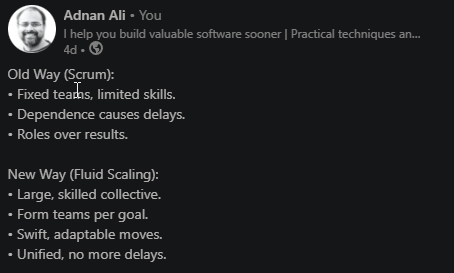AMIA#28 | Scrum, SAFe and the Time to Move On
Aha! Moments in Agility
Live in your inbox every Sunday to help you build valuable software sooner
AMIA: #28
Reading Time: ~ 3 minutes
The Celebrities Might Be At An End
Scrum is the most famous and widely adopted agile framework.
It has a very large community of practitioners, coaches, trainers, masters and teams.
SAFe is the most famous and widely adopted scaling framework for Scrum.
It too has a large community of practitioners, coaches, trainers, masters and teams.
SAFe is what people turn to when they want to ignore or in some cases genuinely unable to untangle the web of interdependencies between Scrum teams.
Yet, if you ask the people who do the work, the people who participate in defining and completing the work, a majority is not happy with this way of working.
Somehow, somewhere, between the promise and implementation, the prescription and dogma from the purists of these frameworks…
we’ve lost agility.
we’ve lost discovery and creativity.
we’ve lost sight that business agility is not the user’s problem.
Agility is a business solution to a business problem that exists in complexity.
Scrum is Old Way
When I posted this on LinkedIn this week, someone commented:
“if scrum doesn’t work in one context, do we need to trash it and call it old way?”
My response: Scrum is the most famous and one of the oldest framework used and adapted at mass to introduce agility in businesses. So yeah, it's old and calling it so isn't trashing it.
Remember the manifesto for agile software development starts with:
We are uncovering better ways of developing software by doing it and helping others do it.
“We are uncovering… by doing it…”. It doesn’t say we have uncovered and now that’s done.
So yeah, Scrum is the old way. Which brings me to the point of this newsletter.
Alternative Scaling Frameworks
There are other scaling frameworks as alternatives to SAFe:
Scrum.org has the Nexus framework
Large Scale Scrum (LeSS)
Disciplined Agile (DA) - Not a framework, more like a toolbox
Most of these scaling frameworks use single team Scrum as the base.
But, the bigger question is about moving on from Scrum and scaling frameworks.
Time to Move On
There is a growing understanding that the organisations pursuing business agility need to re-think and transform as a whole rather than transforming processes and teams.
The main thrust of the future of agility at work is around the ideas of self-organisation, making work truly enjoyable and rewarding and removing the negativity of splitting work across multiple teams and building coordinating hierarchies to keep them in sync, and removing dependencies.
The theory is coming from:
Teal organisations - Reinventing Organisations
The practice is taking shape in different parts of US, Europe and Australia:
Fluid Scaling Technology for Agile (FaST)
James Shore is pioneering implementation of FaST
Aqua is a open systems, dynamic reteaming system being developed and piloted in Australia by Sam Zawadi.
I have explored FaST before in Aha Moments in Agile #11:
AMIA#11 | Exploring FAST: An Alternative Agile Framework
Aha! Moments in Agility Live in your inbox every Sunday to help you build valuable software sooner AMIA: #11 Reading Time: ~ 3 minutes
I will be writing more about the way forward from our current collective inertia with Scrum and SaFE.
When you’re ready…
I can help you in 3 ways:
Check out the resources list
Forecast timelines like a Pro in under 1 minute - Zero Estimate System
Fix the root cause of bugs & defects in your team - Root Cause Analysis Template
Book One on One coaching with me - Become a go-to Scrum Master in your organization.
Find me on LinkedIn and introduce yourself :)


